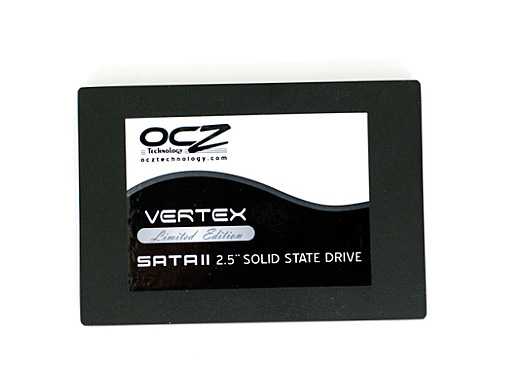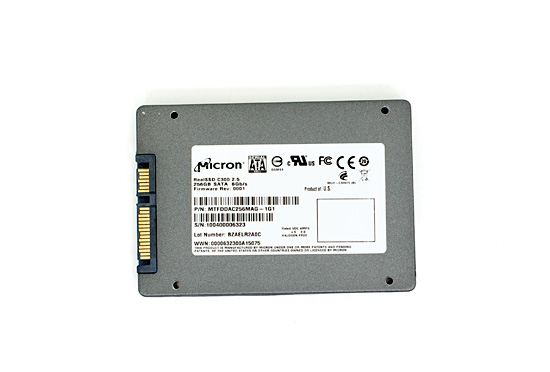OCZ’s Vertex Limited Edition Review & SSD State of the Union
by Anand Lal Shimpi on February 19, 2010 12:00 AM EST- Posted in
- Storage
Final Words
If you were one of the first customers to buy an X25-M G1 or G2, these new drives are fast but not fast enough to make you want to ditch your drive. At the same time, if you’re looking to make the jump to what I’ve often referred to as the single best upgrade you can purchase for your PC, these new drives don’t do anything to lower prices. At $399 the 100GB Vertex LE is no better of a deal than the existing Indilinx offerings. The $499 Crucla RealSSD C300 takes price in the wrong direction as well. If you were waiting for SSDs to get cheaper, you’ll have to wait even longer for the transition to 25nm MLC NAND flash in Q4.
That being said, there is value to be gained from today’s announcement. At $399 you are getting more SSD for your money than you will be able to get when the SF-1200 based Vertex 2 drives ship later this year. The only unknown is how much performance you’ll give up by going to a cheaper SF-1200 drive. I've heard that the maximum read/write speed of the SF-1200 will be similar to the SF-1500, but random performance is unknown at this time. Ultimately how much worse the SF-1200 performs will dictate how valuable the Vertex Limited Edition actually is.

Make no mistake - the Vertex Limited Edition is fast. Easily faster than the SSD posterchild Intel’s X25-M, across the board. It’s only in our heavy multitasking/downloading workload that the SandForce’s controller shows its soft spot. When tasked with a great deal of compressed writes, the SF-1500 controller performs no better than last year’s Indilinx Barefoot. At least with the Vertex LE you’re not paying a price premium for it.
The Vertex LE boasts sequential performance that easily hits the limits of 3Gbps SATA. Doing so with reads isn’t that hard, but with writes it’s harder to do. Granted anything you’re writing that’s large enough to transfer at speeds of 250MB/s for more than a couple of seconds is likely highly compressed to begin with and thus you won’t see those transfer speeds to begin with. Such is the great paradox of SandForce’s DuraWrite technology.
Unlike most drives that only offer good sequential performance, the Vertex LE doesn’t use it as a crutch. Random read and write performance is spectacular, regardless of OS or partition alignment. Under Windows 7, the Vertex LE can randomly write data in 4KB at 162.2MB/s. That’s faster than Intel’s X25-M G2 can write sequentially.
Then we have Crucial’s RealSSD C300, which you are paying a price premium for. Starting at $499 the C300 commands a higher price than any other SSD on the market with 128GB of MLC NAND flash. As a result you get the only 6Gbps compatible SSD on the market, and the performance to back it up.

At first glance it is the most Intel-like of any of the SSDs here. Its performance comes without any stipulations as to the type of writes you have to be doing, it just always delivers.
Sequential and random performance is stellar, although out of the box it doesn’t deliver the best performance under Windows XP. Pair it with a more modern OS that is 4K-aware and its performance easily rivals the SF-1500. Give it access to a 6Gbps SATA controller and it’ll deliver higher sequential read speeds than we’ve ever seen from an SSD.
The RealSSD C300’s random write performance under Windows 7 is slightly behind the Vertex LE, but its random read performance is much better.
Real world performance of the C300 is nothing to scoff at. It’s easily in the top 3 of all SSDs we’ve ever tested, and arguably the fastest MLC SSD on the market. Especially if you pair it with a 6Gbps SATA controller. The only thing that worries me about the C300 is its unusually high max write latency. Admittedly it pokes its head up very rarely and average write latency is second only to the Vertex LE, but OSes don’t always respond well to unexpectedly high write latencies. It’ll be something to keep an eye on as I get more time with the C300.
Our final newcomer is the Kingston SSDNow V+ Series drive. Priced at $399 it continues the trend of not driving prices lower, just offering alternatives. The 128GB drive I tested performed extremely well in some cases such as our heavy multitasking/downloading Bench workload. In others, the drive was much less impressive. The Toshiba controller doesn’t do well in random write performance, mimicking the Samsung RBB controller it often competes with in OEM machines. The fact that I wasn’t able to get TRIM working is also cause for concern. If Kingston could drop the price on the drive and get the TRIM support working it might be an interesting alternative to Samsung based drives.
Now we get to the hard part, recommendation time.
There’s this convergence of SSDs with 128GB of NAND at the $399 price point. Generally at or around $399 you can get something with 128GB of NAND. Controller offerings at this price point are Indilinx, Intel, Samsung and now SandForce.
Assuming the drive is totally reliable, and there’s no chance of any bugs creeping up that OCZ/SandForce missed, the Vertex LE would be the absolute best buy at $399. You’ll notice that my recommendation comes with a huge caveat. The last SF-1500 drive I had died after two weeks. Admittedly it was a beta, but this is also SandForce’s first drive shipping to consumers ever. I think it’s more than fair to be cautious.
If you’re willing to take the risk, the Vertex LE appears to be the best SSD you can buy at $399. It is a difficult proposition simply because we have had such limited experience with the drive and the controller/firmware have a completely unproven track record. It really boils down to how much of an early adopter you are. At least OCZ as a company tends to take care of its customers, so even if you do take the jump and something does go wrong you won’t be SOL. The Vertex LE will ship with a 3 year warranty and if your drive dies you'll get another LE (OCZ is putting some aside), Vertex 2 or other equivalent in its place.
OCZ’s CEO Ryan Petersen and I could always get into another yelling match if you aren’t taken care of.

If you're not willing to risk it, Intel or Indilinx are your best bets. Intel for best random performance, or Indilinx for better sequential write speed and cost.
Go up another $100 and the recommendation is easily the Crucial RealSSD C300. Again, assuming that nothing horrible ever happens with the drive. I do have more faith in Crucial’s validation testing given that Micron is shipping the same drive to OEMs, but it’s still a brand new, unproven platform. It is good to see Crucial/Micron actually embracing new technology instead of shying away from it. The combination of ONFI 2.0 NAND and 6Gbps SATA give the C300 an advantage that no other drive can match.
It's the price point that I'm really not comfortable with. When Intel launched the X25-M at nearly $600, it was fine because no other drive came close. With real world performance of the C300 virtually indistinguishable from the competition, it's difficult to justify that extra $100. Granted in more I/O bound cases, the C300 does have some extra value - I just question whether or not that's worth an extra $100.
While performance is surely improving, price is not. We'll have to wait until Q4 for that. The fact that Intel's roadmaps show the X25-E using 34nm MLC NAND means things are going to get very interesting for enterprise SSDs in 2011.










83 Comments
View All Comments
v12v12 - Tuesday, February 23, 2010 - link
"To calm your fears, OCZ is selling the Vertex LE with a 3 year warranty."Umm 3yrs is CRAP! It's the industry standard among ALL HDs... again, how many times do I have to catch Anand-staff soft-wrist-slapping these con-artist manufacturers?! Who's "assured" with a 3yr warranty vs what? I haven't seen any manu offering lower? So how's that a selling/assurance point... let alone if it's even VALID to list in this article?
What you should have said (if at all) was:
"To calm your fears, OCZ is selling the Vertex LE with a STANDARD 3 year warranty (just like everyone else)." Hahaha.
I just don't get how you can continue to soft-scold (more like a notation) these manufactures when you and I KNOW it's crap. Well Okay I DO know; you're smart and running a business/review site (pro-business) and you don't wanna bad mouth these guys like you OUGHT to do. So instead you'll give them wrist slaps at the end of all the journalist-sensationalism in order to wash over the apparent chicanery of these businesses, so they'll keep sending you beta/new samples... Yes I know how the POLITICS of "business" works these days; sucks for the avg-minded consumer who totally misses keystone issues like this for all the hype and grandeur laced commentary... Sigh, the consumer-cattle loses again.
OWC Grant - Tuesday, February 23, 2010 - link
FWIW to this discussion thread and wasn't covered in the brief mention, the OWC Extreme Enterprise comes with an enterprise class level warranty...FIVE years. So, based on pricing and other similarities, will leave it up others to decide what the best value/performance ratio is in SSDs.kunedog - Tuesday, February 23, 2010 - link
Let's also not forget that he *never* acknowledged the near-immediately stratospheric pricing of Intel's G2 X-25M, right after he praised its affordability:http://www.anandtech.com/storage/showdoc.aspx?i=36...">http://www.anandtech.com/storage/showdoc.aspx?i=36...
He mentioned the firmware problems and lack of stock once but never the pricing.
ONLY now, over 6 months later, do we see prices anywhere near what he predicted at release:
80GB for $220
http://www.newegg.com/Product/Product.aspx?Item=N8...">http://www.newegg.com/Product/Product.aspx?Item=N8...
160GB for $430
http://www.newegg.com/Product/Product.aspx?Item=N8...">http://www.newegg.com/Product/Product.aspx?Item=N8...
The 160GB comes with a free Apricorn USB enclosure, the same one "randomly plugged" here by Anand. It's a strange coincidence to see two sites decide to associate it with SSDs (why would you put an SSD in an USB enclosure?).
shin0bi272 - Monday, February 22, 2010 - link
I thought I saw a review on anandtech a few months ago about the corsair p128 which was supposed to be a great ssd. But its not included on these benchmarks. Its supposed to have 220mb seq read and 200mb seq write. yet its not included? why?OWC Grant - Monday, February 22, 2010 - link
Glad to see so much interest in SSD!As Anand was made aware, our earliest units went out to reviewers and we contacted him and other reviewers to get these units back upon learning of a firmware revision that became available early Feb. In direct communication with him, he noted that neither firmware version had any effect on the performance.
All other OWC SSD units in the field (and available with same day to 1 day delay shipping from OWC) do have the latest firmware revision.
So, we are not "a bit behind OCZ" in this regard.
Hope this clears up the matter...and that you get an OWC SSD for yourself!
smith11 - Monday, February 22, 2010 - link
There's something that I'm not getting...If there's 0.5x write amplification because of real-time compression, why wouldn't the effective capacity be a good bit higher than (the non-reserved part of) the physical capacity ???
GullLars - Monday, February 22, 2010 - link
When i was reading this test, i couldn't help but think on several occasions that a cheap RAID of 3-4 intel x25-V from ICH10R would beat many of the drives tested here, and at a lower price.4 x25-V in RAID 0 gives 160GB capasity, roughly 600 MB/s seq read (limited by ICH10Rs bandwidth), about 140-150 MB/s seq write, around 100.000 4KB random read IOPS (400MB/s) at higher queue depths, and about 40.000 4KB random write IOPS (120MB/s). At a price point around $400-450, wich is about the same as Intel x25-M G2 160GB costs...
I think it would be great if Anand could do a test with 4 x25-V in RAID 0 from ICH10R to demonstrate a budget concious enthusiast setup.
semo - Monday, February 22, 2010 - link
Hi Anand,Great article. Any word on PCI-e SSDs? Are you leaving them out because of high costs or other reasons?
Also, good to know that you have our backs if those SSDs start crapping out. Without people like you companies get away with it for a long time.
rubbertoe - Sunday, February 21, 2010 - link
Looks like Amazon is also selling the 100G version:http://www.amazon.com/gp/product/B0035RQZSG/ref=pd...">http://www.amazon.com/gp/product/B0035R...X0DER&am...
Can someone confirm this is the drive that was reviewed? With selling only 5,000 does anyone have any idea how they will be distributed into the retail channels?
RT
neoflux - Sunday, February 21, 2010 - link
The OCZ Agility uses Intel 50nm or Toshiba 40nm flash.The OCZ Solid 2 uses Intel 34nm flash.
The OCZ Vertex uses Samsung flash, but what SIZE?
And based on that size, if the controller is the same as Anand mentioned a few articles ago, is the Solid 2 faster or at least the same speed-wise as the Vertex?
I did find that the Solid 2 may actually have some sort of 'crippled' Indilux controller, but that was just some forum, not an article.
I have gone back through all the Anand articles and googled everything I could think, but could not find the answer.
Someone enlighten me as to the size of the flash and the speed compared to the Vertex?